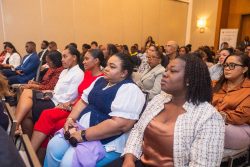Santa Rosa’s leaders yesterday urged authorities to rectify what they say has been the longstanding issue of the improper demarcation of the village’s lands, which continues to stifle development.
Toshao of Santa Rosa Sherwin Abrams, former Toshao Basil Cornelius and Village Council member Graham Atkinson presented the concerns on behalf of Guyana’s largest indigenous village at a press conference at the Amerindian Peoples’ Association (APA) offices.
Toshao Abrams indicated that they have met with Minister of Indigenous Peoples’ Affairs Sydney Allicock and were able to present their findings showing that the demarcation was not properly done.
As a result, the minister has committed to organising a “high level” team to visit the community in order to corroborate the findings and determine a way forward.
Nevertheless, Toshao Abrams indicated that the village is no longer interested in waiting around to have the issue rectified and that the meeting was sought with the minister with the intention of discussing the way forward.
“We are no longer sitting back and waiting; we are here confronting the issue. We are not blaming any government, past or present, we are just here to find a solution for the way forward. It’s been more than a decade now that we have been faced with this issue… and we don’t have to have any issues with our neighbours.
We don’t have any border disputes presently but for the future we never know what can happen so we see it as a way to resolve it before we get any issues arising,” Abrams said, while adding that it is the community’s desire to resolve the situation in a peaceful and amicable way.
Former Toshao Cornelius, who is Chairman of the Moruca Land Council, explained that the Guyana Lands and Surveys Commission (GL&SC), during demarcation in 2006, did not fully follow the 1976 land description and as a result several communities have been cut off from their legal description.
This, he said, has caused residents to have “feelings of insecurity,” when it comes to their access to land and self-development.
“We are not professional surveyors but what we did was to walk our description as to what the 1976 Act told us and so we did walk and followed the description and that is what showed us. On the other end, we couldn’t walk because there is very rough terrain. But we have proof, solid proof that our boundary is incorrect. What legally we supposed to have, we were robbed because of what I would say is the haphazard way our village was demarcated,” Cornelius said.
Similar sentiments were shared by councillor Atkinson.
“Our contention is based on facts…we have done the hard work. Like Basil said, we are not professional land surveyors but we walked our boundaries; we took time to speak to our elders, we did the research and so we are very happy that the ministry welcomed the move and we are happy to facilitate them in villages, take them to these places. Let us go on the ground and sort it out,” he remarked.
“We are laying it all here on the table because we have had from 2006 to now, almost 11 years of this going on and on. We have been mandated to solve this matter and in the time we have available to us we are going to put the options in place to have this matter resolved,” Atkinson added.
However, if the issue persists without any resolution, they indicated that the council may consider taking the matter to the High Court for redress.
According to a Participatory Assessment of the Land Tenure Situation of Indigenous Peoples in Guyana (Report for Region 1 and Region 2), which was compiled and published by the APA in November, 2016, Santa Rosa has continued to face land issues despite being granted a land title.
It was further noted that though complaints were made to the GL&SC that the demarcation did not follow the title description, these complaints were dismissed and the village was pressured into accepting demarcation.
As a result at least six families on the Cabrora Creek along with some at Karaburi (7 miles) are now technically residents of Waramuri. Many homesteads on the Kumaka-Kwebanna road are also reportedly unsure on whether they live on ‘state land’ or on Santa Rosa’s titled land, since the map of the surveyed boundary description states that the title includes all lands “save and except all 1st and 2nd depths of lots” along the Kumaka-Kwebanna road.
Additionally, residents claimed that the large population of Santa Rosa and its recent rapid growth were putting stress on their natural resources and that development is stifled by the lack of available resources within the titled community.
The village had applied for a title extension in 2008, however, it was later informed that the file had gotten lost in the system for seven years.
Additionally, the report stated that in 2012, the government ignored the collective application of the Moruca Land Council (a coalition of six Amerindian villages including Santa Rosa) for a common title to shared customary lands.
Nevertheless, in March, 2015, the GL&SC made an initial investigation visit to the community, however, the findings of the subsequent report were rejected by the community as it was said to have contained errors that were unacceptable.





